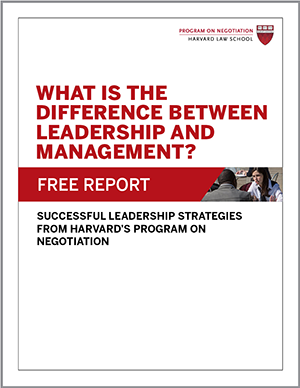
When old business models no longer serve us well, strategic leadership is needed to adapt to new times and conditions. This was true when entertainment-industry disrupter Netflix and two major U.S. theater chains tried to negotiate a wide theatrical release for The Irishman, the Netflix-financed Martin Scorsese film. Their impasse highlights the important role of leadership in negotiation.
A Deal and a Promise
When Scorsese—whose body of work includes Taxi Driver, Goodfellas, and The Departed—began shopping a screenplay about labor-union official and self-proclaimed mafia hit man Frank Sheeran, Hollywood executives questioned whether it could turn a profit. The Irishman was expected to run more than three hours and cost over $100 million.
Paramount Pictures bought domestic distribution rights to the film—but bowed out after its budget ballooned to over $125 million. With no other appealing options, Scorsese sold world rights to The Irishman to Netflix. The partnership secured him a big budget, and Netflix promised to try to negotiate a significant theatrical release for the film before its streaming debut.
A Wide Window
In 2019, Netflix began negotiating The Irishman’s theatrical release with multiplex chains AMC Theatres and Canada’s Cineplex. In addition to meeting its obligation to Scorsese, another strategic leadership goal for Netflix was offsetting some of the film’s final $159 million price tag with box-office receipts.
Though a win-win agreement seemed in sight, talks quickly hit a roadblock over the “three-month theatrical window”—the exclusive period of time that theater companies reserve to show films before they can be released in other formats, including streaming. Netflix refused to make its approximately 150 million subscribers wait three months to view The Irishman at home.
The theater companies were in a quandary. If they agreed to shorten The Irishman’s theatrical window, Hollywood studios would demand shorter windows for their films. With ticket sales in decline, theater executives feared that narrowing the window would lead more consumers to skip their local multiplex entirely. Two other movie mega-chains, Regal Cinemas and Cinemark, passed on bidding for The Irishman, calling the three-month window nonnegotiable.
That’s a Wrap
Over several months, AMC and Cineplex agreed to shorten the three-month window to about 60 days for The Irishman, according to the New York Times. Netflix refused to go above 45 days. Negotiations ground to a halt.
Netflix appeared to calculate that chasing box-office revenues could be a distraction from its goal of signing on new members, especially the older Scorsese fans they hoped to attract with The Irishman. Moreover, Netflix didn’t need the big theater chains to meet its minimum commitment to Scorsese: Numerous independent theaters and small theater chains were willing to show the film without a three-month window. The Irishman played at a small number of screens in some major U.S. cities over several weeks in November.
Lights, Camera, Action
New streaming services from Apple, Disney, and others are creating fierce competition for Netflix, as well as a new set of demanding negotiating partners for theater chains. The shuttering of movie theaters across the globe as a result of the Covid-19 pandemic has put further pressure on the chains to loosen their three-month window.
In negotiations with Universal Pictures, AMC showed both industry and organizational leadership by agreeing to shorten the theatrical window for some smaller films to 17 days in exchange for a percentage of Universal’s earnings from premium on-demand rental revenue. “The movie business will never look the same,” Variety declared, predicting other studios and theater chains would reach similar agreements.
Adapting to Industry Change
When the future remains out of focus, effective leadership often means recognizing that refusing to change is likely the riskiest option of all. These guidelines will enable strategic leadership that moves beyond the status quo:
- Look past the numbers. Arguing over a single contentious issue rarely prompts win-win deals. Bring a host of other issues to the table to identify overlooked opportunities and potential trades across issues.
- Encourage a gain frame. When thinking about the future, we tend to focus more on what we could lose than on potential gains. Try to move leadership styles beyond a “loss frame” by highlighting what everyone could gain—and how outdated business models are holding back all parties.
- Bring everyone to the table. When an industry is in upheaval, cutting creative deals with one party at a time can generate more turmoil. Show strategic leadership by inviting all relevant parties to contribute novel ideas aimed at creating value for all.
Have you witnessed strategic leadership in your organization’s negotiations?





